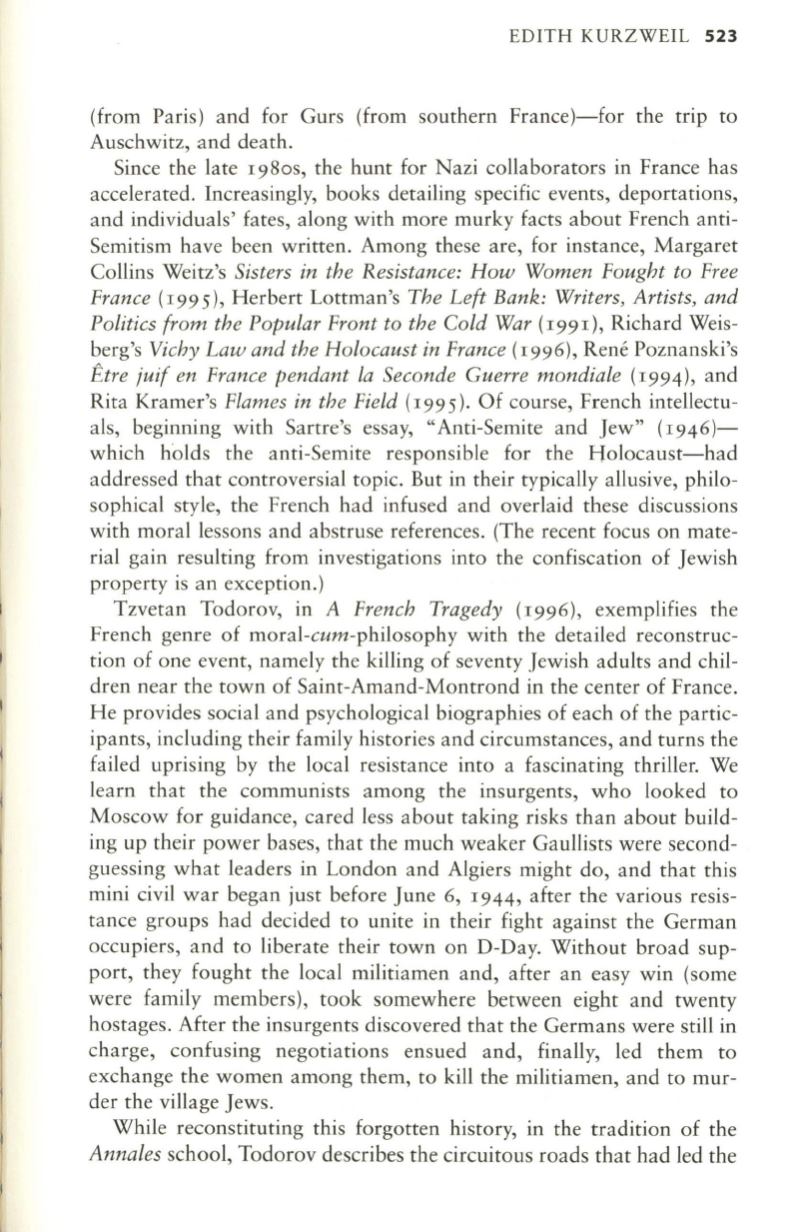
EDITH KURZWEIL
S23
(from Paris) and for Gurs (from southern France)-for the trip to
Auschwitz, and death.
Since the late 1980s, the hunt for Nazi collaborators in France has
accelerated. Increasingly, books detailing specific events, deportations,
and individuals' fates, along with more murky facts about French anti–
Semitism have been written. Among these are, for instance, Margaret
Collins Weitz's
Sisters in the Resistance: How Women Fought to Free
France
(1995), Herbert Lottman's
The Left Bank: Writers, Artists, and
PoLitics from the PopuLar Front to the CoLd War
(1991), Richard Weis–
berg's
Vichy Law and the HoLocaust in France
(1996), Rene Poznanski's
Etre juif en France pendant La Seconde Guerre mondiaLe
(1994), and
Rita Kramer's
FLames in the Field
(1995). Of course, French intellectu–
als, beginning with Sartre's essay, "Anti-Semite and Jew" (1946)–
which holds the anti-Semite responsible for the Holocaust-had
addressed that controversial topic. But in their typically allusive, philo–
sophical style, the French had infused and overlaid these discussions
with moral lessons and abstruse references. (The recent focus on mate–
rial gain resulting from investigations into the confiscation of Jewish
property is an exception.)
Tzvetan Todorov, in
A French Tragedy
(1996), exemplifies the
French genre of moral-cum-philosophy with the detailed reconstruc–
tion of one event, namely the killing of seventy Jewish adults and chil–
dren near the town of Saint-Amand-Montrond in the center of France.
He provides social and psychological biographies of each of the partic–
ipants, including their family histories and circumstances, and turns the
failed uprising by the local resistance into a fascinating thriller. We
learn that the communists among the insurgents, who looked to
Moscow for guidance, cared less about taking risks than about build–
ing up their power bases, that the much weaker Gaullists were second–
guessing what leaders in London and Algiers might do, and that this
mini civil war began just before June 6, 1944, after the various resis–
tance groups had decided to unite in their fight against the German
occupiers, and to liberate their town on D-Day. Without broad sup–
port, they fought the local militiamen and, after an easy win (some
were family members), took somewhere between eight and twenty
hostages. After the insurgents discovered that the Germans were still in
charge, confusing negotiations ensued and, finally, led them to
exchange the women among them, to kill the militiamen, and to mur–
der the village Jews.
While reconstituting this forgotten history, in the tradition of the
AnnaLes
school, Todorov describes the circuitous roads that had led the


